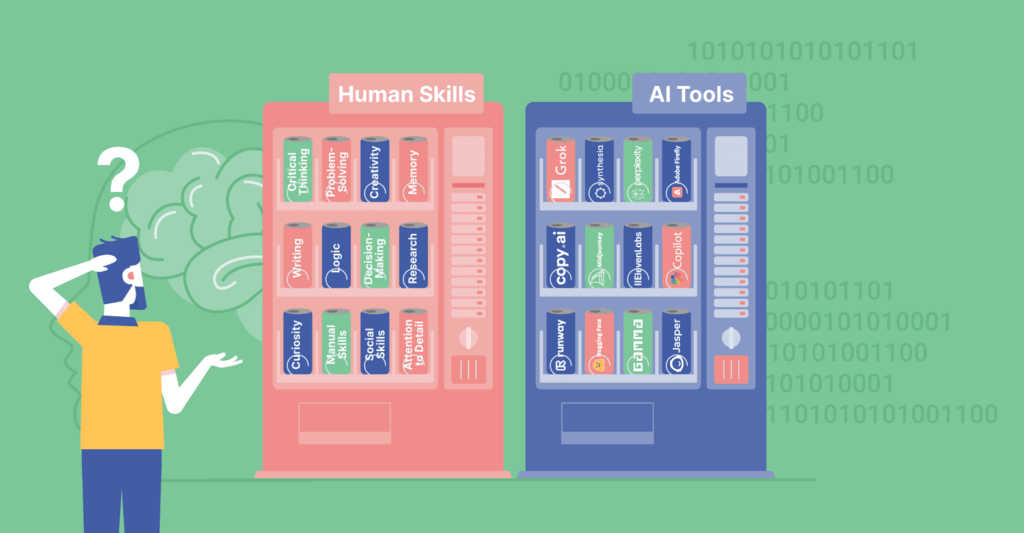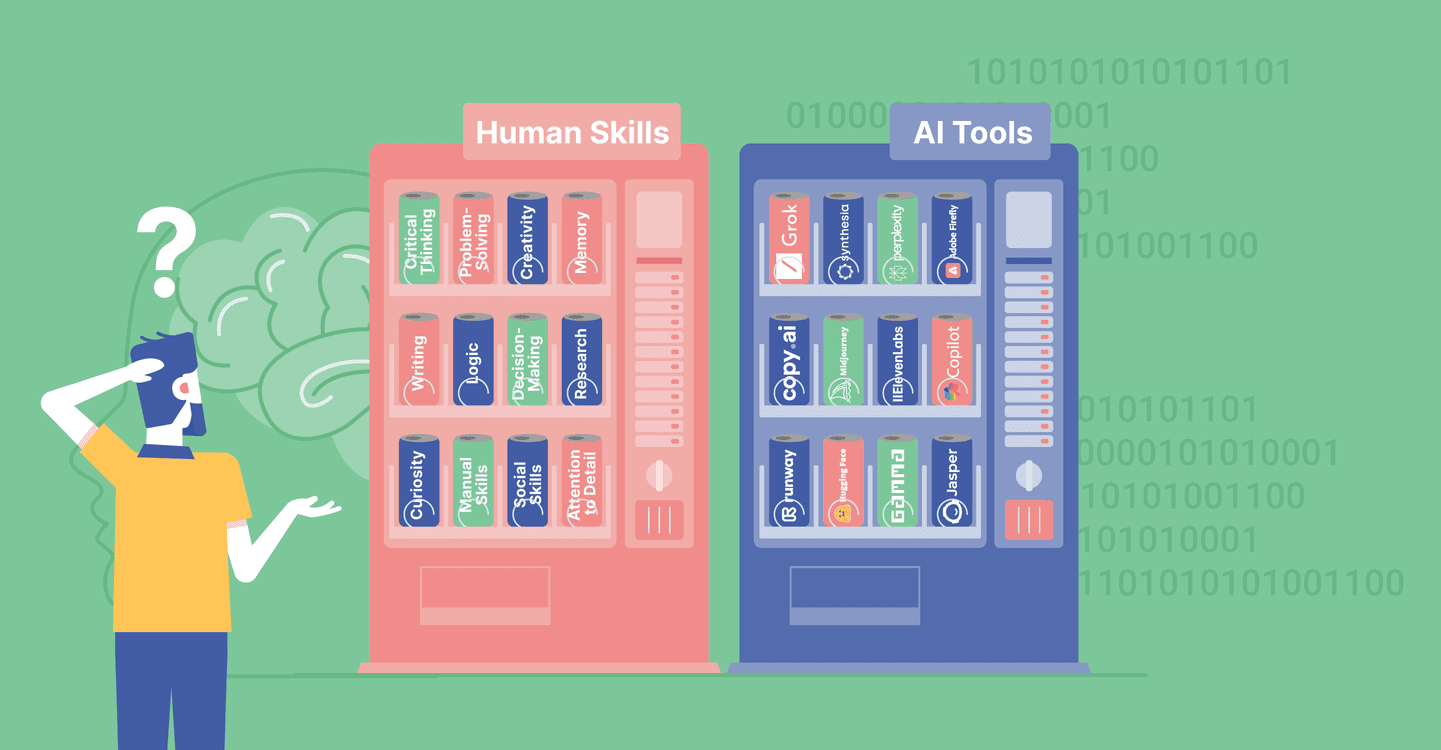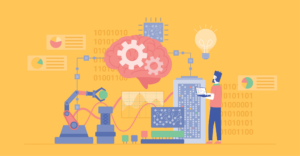Beyond powerful models, AI tools play a crucial role in bridging the gap between cutting-edge technology and real-world implementation. These tools provide the frameworks, platforms, and integrations that make AI accessible, scalable, and adaptable for businesses of all sizes. From no-code development platforms to advanced MLOps solutions, AI tools are streamlining workflows, enhancing productivity, and accelerating digital transformation.
In this article, we’ll explore the top AI tools that are empowering enterprises to harness the full potential of artificial intelligence.
At A Glance

Grok
Grok is an AI-powered assistant tightly integrated into X (formerly Twitter). It helps users manage tasks, streamline communication, and interact more efficiently within the platform. Grok’s main strength is its ability to analyse and process large amounts of social media data, making it a valuable tool for enhancing productivity and engagement within such digital ecosystems.
Grok Background
Grok was launched by X (formerly Twitter) in 2023, under the xAI banner. Built to integrate with the X platform, Grok aims to enhance user engagement, automate tasks, and offer intelligent insights, focusing on making social media management and interactions more efficient and data-driven.
Top Grok Uses:
- Automated Social Media Management: Assisting with managing and scheduling posts across social platforms.
- Conversation Insights: Analysing interactions to provide actionable insights and trends.
- Task Automation: Streamlining repetitive tasks through conversational interfaces.
- Customer Engagement: Enhancing customer service and interactions with AI-driven responses.
- Data-Driven Recommendations: Providing real-time suggestions based on user interactions and behaviours.
Synthesia
Synthesia is an AI-driven video generation platform that creates realistic, customisable video content using avatars. It allows users to transform text into videos without the need for actors, cameras, or studios. Synthesia is widely used for corporate training, marketing, and instructional videos, making it a powerful tool for businesses looking to streamline content production with minimal resources.
Synthesia Background
Synthesia, founded in 2017, specialises in AI-powered video generation. By allowing users to convert text into lifelike videos featuring AI avatars, it revolutionised content creation, making video production scalable and accessible across industries like education, marketing, and corporate training.
Top Synthesia Uses:
- Video Content Creation: Transforming text into professional, AI-generated videos with ease.
- Training and E-learning: Producing educational videos with AI avatars for scalable learning solutions.
- Marketing and Branding: Crafting engaging video content for product promotions and brand storytelling.
- Localised Video Production: Generating videos in multiple languages, enabling global reach.
- Internal Communications: Creating internal video updates and tutorials quickly and efficiently.
ElevenLabs
ElevenLabs is a tool which specialises in AI-based voice synthesis, offering hyper-realistic text-to-speech technology. It allows users to create natural-sounding, customisable voices for various applications, from audiobooks and podcasts to customer support systems. With its ability to generate multiple languages and accents, ElevenLabs is becoming a key player in industries requiring high-quality voiceovers and audio content.
ElevenLabs Background
ElevenLabs, founded in 2022, is an AI platform custom-built for voice synthesis. It focuses on creating ultra-realistic and expressive voices, transforming how audio content is generated across industries like entertainment, education, and accessibility.
Top ElevenLabs Uses:
- Voiceover Creation: Generating realistic, human-like voices for videos, podcasts, and other media.
- Audiobook Narration: Turning written content into professional audio narratives with diverse voices.
- Multilingual Voice Support: Producing high-quality voiceovers in multiple languages.
- Accessible Content Creation: Making content accessible for visually impaired users through natural voice synthesis.
- Custom Voice Generation: Creating personalised voices for branding, entertainment, or storytelling.
Perplexity
Perplexity is a cutting-edge tool focused on delivering accurate and concise answers to user queries by integrating search functions with large language models. Its primary strength lies in combining the best of search engines and AI-driven conversation, making it useful for professionals seeking fast, reliable, and data-backed information. It is particularly effective in research and decision-making environments where quick access to relevant data is key.
Perplexity Background
Perplexity AI, launched in 2022, is an AI-powered search engine focused on delivering precise, conversational answers. Designed to enhance information retrieval, it combines advanced natural language processing with search technologies, enabling users to quickly find and understand complex information.
Top Perplexity Uses:
- Fast Information Retrieval: Providing quick, accurate answers to queries using AI-driven search capabilities.
- Research Support: Assisting with finding relevant data, sources, and insights for in-depth research.
- Content Summarisation: Simplifying complex information into concise, understandable summaries.
- Learning and Education: Enhancing knowledge acquisition by delivering precise answers across various fields.
- Product Recommendations: Offering tailored suggestions based on user inquiries and preferences.
CopyAI
CopyAI is a content generation tool powered by AI, specifically designed to help users quickly create marketing copy, blog posts, and other forms of written content. With its intuitive interface and templates, CopyAI enables non-technical users to produce high-quality content in a fraction of the time it would take manually. It’s a favoured tool for marketers, content creators, and businesses aiming to scale their content strategies.
CopyAI Background
CopyAI was launched in 2020 as an AI-driven writing tool designed to assist marketers, content creators, and businesses. Its many functions and features have evolved and developed substantially as the tool has grown. By leveraging advanced natural language processing, it aims to streamline content generation, making it faster and easier for users to produce high-quality written material.
Top CopyAI Uses:
- Marketing Copy Generation: Crafting compelling ad copy and product descriptions in seconds.
- Social Media Content: Generating engaging posts and captions tailored to different platforms.
- Blog and Article Writing: Assisting writers with ideas and outlines for informative content.
- Email Campaigns: Creating persuasive email content for outreach and engagement.
- Creative Storytelling: Helping authors develop plots, characters, and narratives efficiently.
Midjourney
Midjourney is an AI-based image generation tool that allows users to create stunning visuals from text prompts. Known for producing high-quality and artistic results, it’s widely used by designers, marketers, and artists for creative projects. Midjourney leverages advanced diffusion models to generate images that range from abstract art to photorealistic visuals, making it a favourite in creative industries.
Midjourney Background
Midjourney was launched in 2022 with the objective of generating high-quality images from textual descriptions. It has gained popularity for its ability to produce artistic and creative visuals, making it a valuable tool for artists, designers, and marketers seeking innovative ways to bring their ideas to life.
Top Midjourney Uses:
- Art and Illustration Creation: Generating unique artwork and illustrations from text prompts.
- Concept Visualisation: Assisting designers in visualising concepts and ideas quickly.
- Marketing Visuals: Crafting stunning graphics for marketing campaigns and promotions.
- Game Design Assets: Producing visual elements and environments for video games.
- Storyboarding and Visual Narratives: Helping creators develop visual narratives for films and animations.
Adobe Firefly
Adobe Firefly is Adobe’s generative AI tool designed to create images, text effects, and 3D elements with ease. Integrated into Adobe’s suite of creative software alongside Photoshop and Illustrator, Firefly enhances productivity by allowing users to generate custom designs through simple prompts. It’s a powerful tool for digital content creators, offering streamlined workflows and producing professional-grade visual content.
Adobe Firefly Background
Adobe Firefly, launched in 2023, is a suite of AI-driven creative tools designed to enhance graphic design workflows. By leveraging generative AI, it enables users to quickly produce high-quality visual content, making it easier for creators to bring their ideas to life while maintaining consistency and brand identity.
Top Adobe Firefly Uses:
- Graphic Design Automation: Streamlining the creation of high-quality graphics and visuals.
- Creative Content Generation: Producing unique designs, images, and illustrations from simple prompts.
- Branding and Marketing Materials: Assisting in the rapid development of brand assets and promotional content.
- Social Media Graphics: Crafting eye-catching visuals tailored for various social platforms.
- Interactive Prototypes: Enabling designers to create interactive prototypes with integrated visuals.
Copilot
GitHub Copilot, developed by OpenAI and GitHub, is an AI-powered coding assistant that helps developers write code faster and with fewer errors. It integrates directly into code editors like Visual Studio Code and suggests whole lines or blocks of code based on the context of the project. Copilot has become a valuable tool for improving developer productivity, especially in large and complex software projects.
Copilot Background
Copilot, developed by GitHub and OpenAI, was launched in 2021 as an AI-powered code completion tool. It leverages machine learning to assist developers by providing context-aware code suggestions, thereby enhancing productivity and streamlining the coding process across various programming languages.
Top Copilot Uses:
- Code Autocompletion: Offering real-time suggestions and completions for programming code.
- Bug Detection: Identifying potential bugs and providing solutions during development.
- Documentation Generation: Creating comprehensive documentation based on code comments and functions.
- Learning Support: Assisting developers in learning new programming languages or frameworks through contextual hints.
- Collaborative Coding: Enhancing teamwork by providing shared insights and coding suggestions during collaborative sessions.
Runway
Runway is a creative toolkit powered by AI, specialising in video editing, visual effects, and media production. It allows users to generate and manipulate visual content using machine learning models, making complex video production tasks like masking, colour correction, and animation much easier. Runway is popular among content creators and filmmakers for its innovative, AI-driven approach to creative workflows.
Runway Background
Runway, launched in 2020, is an innovative platform that combines AI with creative tools for video production. It aims to revolutionise the editing process by offering powerful features for content creators, enabling them to generate, edit, and enhance videos more efficiently while fostering collaboration and creativity.
Top Runway Uses:
- Video Editing and Effects: Simplifying the process of editing videos with AI-assisted features.
- Content Creation: Enabling creators to generate compelling video content from text and images.
- Visual Effects and Animation: Adding professional-grade effects and animations to videos quickly.
- Collaborative Filmmaking: Supporting teams in real-time collaboration for efficient project management.
- Rapid Prototyping: Allowing filmmakers to quickly prototype ideas and visual narratives.
MM1
MM1 is a cutting-edge AI model designed to handle multiple types of inputs, such as text, images, and audio, simultaneously. It excels in tasks that require the integration of diverse data sources, making it suitable for applications like multimedia analysis, advanced content recommendation systems, and AI-driven creative tools. MM1 is pushing the boundaries of AI’s capability in handling complex, multimodal data.
MM1 Background
MM1, or Multimodal Model 1, was developed by Google as part of efforts to use AI to enhance the integration of certain data types. Its focus is on bridging the gap between text, images, and audio, allowing for a more cohesive understanding and generation of information, making it valuable across industries such as education, entertainment, and research.
Top MM1 Uses:
- Integrated Data Analysis: Analysing and interpreting data from various modalities, including text, images and audio.
- Enhanced Machine Learning Tasks: Improving performance in tasks that require the interpretation of multiple data types.
- Content Generation: Creating rich media content that combines text, visuals and audio seamlessly.
- Robust AI Research: Supporting researchers in exploring multimodal AI applications and innovations.
- Interactive AI Systems: Enabling interactive applications that require understanding and generating responses across different modalities.
Hugging Face
Hugging Face is a leading open-source platform for natural language processing (NLP) and machine learning. It offers a vast collection of pre-trained models for tasks such as text generation, translation, and sentiment analysis. Hugging Face’s model hub is widely used in both research and industry to accelerate AI development, with a focus on ease of use, collaboration, and cutting-edge innovations.
Hugging Face Background
Since its relatively early 2016 founding, Hugging Face has become a leader in the AI and NLP community by providing open-source tools and libraries, particularly known for its Transformers library and model hub. The platform promotes accessibility in AI research and development, empowering developers and researchers to share and collaborate on innovative machine learning projects.
Top Hugging Face Uses:
- Natural Language Processing: Providing state-of-the-art models for text classification, sentiment analysis, and more.
- Model Deployment: Simplifying the deployment of machine learning models across various platforms.
- Collaboration in AI Research: Facilitating collaborative development and sharing of AI models and datasets.
- Transformers and Generative Models: Enabling the creation and fine-tuning of advanced transformer models for various applications.
- Community Support and Learning: Offering resources, tutorials, and a community for developers and researchers in AI.
Gamma
Gamma is an AI-powered tool that helps users create presentations, documents, and webpages by transforming raw content into polished, professional layouts. It simplifies the process of building presentations by generating designs based on text input, saving time for professionals who need to produce high-quality materials quickly. Gamma is especially useful in business settings where visual communication is key.
Gamma Background
Gamma is a brand new tool aimed at enhancing the efficiency of creating visually appealing and informative presentations. By leveraging advanced AI technology, it empowers users to produce professional-quality presentations quickly, making it a valuable asset for business and educational environments.
Top Gamma Uses:
- Presentation Creation: Streamlining the design of professional presentations from textual input.
- Data Visualisation: Transforming complex data into clear, engaging visuals for better understanding.
- Collaborative Projects: Facilitating teamwork on presentation and design projects in real-time.
- Content Structuring: Assisting users in organising and structuring content effectively for presentations.
- Interactive Presentations: Enabling the creation of dynamic presentations with interactive elements.
Pika
Pika is an AI-based image and design tool that focuses on generating high-quality visuals for branding, marketing, and product design. Pika allows users to create professional-grade logos, icons, and other visual elements through simple AI-driven workflows. It’s popular among startups and small businesses looking to streamline their design processes without hiring dedicated designers.
Pika Background
Pika was founded by two Stanford PhD students back in 2023. By leveraging AI capabilities, Pika enables users to quickly prototype, design and analyse projects, facilitating a more efficient workflow and enhancing creativity in the process. It enables smaller companies to avoid hiring a dedicated developer.
Top Pika Uses:
- Rapid Prototyping: Accelerating the development of prototypes for apps and services with AI support.
- User Experience Design: Enhancing UX through quick iterations based on user feedback and AI insights.
- Data-Driven Decision Making: Supporting businesses in making informed decisions using AI-analysed data.
- Marketing Strategy Development: Assisting in creating effective marketing campaigns based on AI-generated insights.
- Content Personalisation: Tailoring content to user preferences and behaviours for improved engagement.
Jasper
Jasper is another AI content generation platform that specialises in creating marketing copy, blog posts and social media content. It employs machine learning to produce tailored content that fits the tone and style of its users, making it an important tool for content marketers and businesses aiming to adjust the scale of their content production. Jasper also offers features for improving SEO, making it a versatile all-rounder tool for digital marketing.
Jasper Background
Jasper was launched in 2021 to help marketers, content creators, and authors produce high-quality text efficiently. By utilising advanced natural language processing, it empowers users to generate compelling content, streamline their writing processes, and enhance creativity across various domains.
Top Jasper Uses:
- Content Creation: Generating high-quality blog posts, articles, and social media content quickly.
- SEO Optimisation: Assisting in keyword research and content structuring to improve search rankings.
- Copywriting: Crafting persuasive marketing copy for ads, emails, and landing pages.
- Creative Writing: Aiding authors with story development, character creation, and dialogue generation.
- Brainstorming Ideas: Offering prompts and ideas to inspire creative projects and campaigns.
Techpresso
Techpresso is an AI-driven tool designed to automate technical documentation, data analysis, and reporting tasks. It streamlines complex workflows by generating reports, summaries, and insights based on large datasets, making it highly useful for IT departments and technical teams. With its focus on technical automation, Techpresso helps reduce the time spent on routine documentation and data management tasks. It generally takes the form of a daily newsletter.
Techpresso Background
Techpresso aims to provide users with the latest news, insights, and resources in the tech industry. By aggregating information from multiple sources, it serves as a comprehensive resource for tech enthusiasts, professionals, and consumers looking to stay informed about advancements and trends in technology.
Top Techpresso Uses:
- Technology News Aggregation: Curating the latest technology news and trends from various sources.
- Market Insights: Providing analytics and insights on technology markets and innovations.
- Product Reviews: Offering detailed reviews and comparisons of tech products and services.
- Educational Resources: Sharing informative articles and guides on emerging technologies.
- Community Engagement: Facilitating discussions and interactions among tech enthusiasts and professionals.
Summary
In 2025, AI tools and models are reshaping how we approach technology and productivity across various fields.
These tools are becoming essential for professionals, helping them work more efficiently and precisely. The progress we’re seeing reflects just how far AI has come in a few short years, now playing a key role in automating processes, fostering innovation, and driving digital transformation. From the realms of academic research to the creative world, these advancements are enabling organisations to stay competitive and unlock new opportunities.



